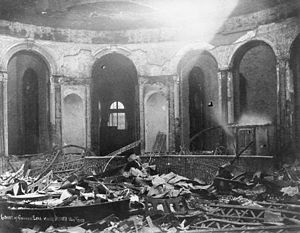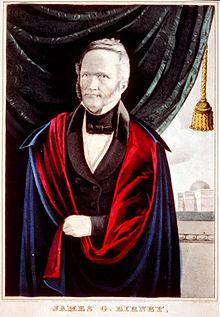- Cincinnati riots
-
There has been a long history of Cincinnati Riots since the city of Cincinnati, Ohio, USA was founded in 1788. Some have been fueled by racial tension, others by issues such as employment conditions and political justice.[1]
Contents
1792
The first riot recorded in Cincinnati was in 1792, after a merchant named John Bartle was beaten by a soldier. Fifty people were involved in the fighting.[1] The riot between settlers and soldiers occurred when spring flooding had driven many people out of their cabins.[2]
1829
By 1829, African Americans numbered almost 10% of the city's population. In the Cincinnati Riots of 1829, about 1,000 of them were driven out of the town by violent mobs. Some of the displaced people moved north to settle in Canada.[1] After the 1829 riots, a growing number of whites became sympathetic to the rights of Negroes, as they were called then.[3]
1836
The Cincinnati Riots of 1836 were caused by racial tensions at a time when African Americans, some of whom had escaped from slavery in the southern states of the USA, were competing with whites for jobs. The riots occurred in April and July.[4] The rioters attacked both Negroes and the whites who supported them.[3] A former slave owner from Alabama, James Gillespie Birney, had become an abolitionist. In January 1836 he set up the Cincinnati Weekly and Abolitionist , a newspaper sponsored by the Ohio Anti-Slavery Society.[5] The newspaper targeted slaveholders across the Ohio River in Kentucky with anti-slavery propaganda. This angered local businessmen who were keen to do business with the southern states.[6] A riot broke out in April in which buildings were burned and several blacks lost their lives. The riot was only brought under control when the governor intervened and declared martial law.[7] In July, the press that printed Birney's newspaper was twice destroyed, and further damage was caused to Negro properties.[8]
1841
Main article: Cincinnati riot of 1841In the Cincinnati Riot of 1841, a mob of white men met in the Fifth Street Market and marched on "Little Africa", an area along the riverfront that was mainly inhabited by African Americans. The blacks were armed and ready, and had a cannon to defend themselves. However, after declaration of martial law 300 of the black men were arrested, and while they were in custody many of their homes were attacked.[9]
1853
The Cincinnati Riot of 1853 broke out on 25 December 1853. An armed mob of about 500 German men with 100 women following marched on the home of Bishop John Purcell, protesting a visit by Cardinal Gaetano Bedini, the emissary of Pope Pius IX. The Germans, many of whom had been involved in the European revolutions of 1848, or whose families had been involved, identified Bedini with the forces of reaction and oppression. One protester was killed and over 60 were arrested.[10]
1855
The Cincinnati riots of 1855 were clashes between "nativists" and German-Americans. The nativists supported J.D. Taylor, the mayoral candidate for the anti-immigrant American Party, also known as the Know-Nothing Party. German-Americans erected barricades in the streets leading into their Over-the-Rhine neighborhood, and fired a cannon over the heads of a mob of nativists attacking them.[1]
1884
The Cincinnati riots of 1884, also known as the Cincinnati Courthouse Riots, were the most violent in the history of the city. They were caused by public outrage over the decision of a jury to return a verdict of manslaughter in a clear case of murder. A mob in Cincinnati, Ohio, USA attempted to find and lynch the man. In the violence that followed over the next few days, over 50 people died and the courthouse was destroyed.[11]
1935
In 1935 a fight between the students at Oyler School in Price Hill, one black and one white, quickly escalated. Police were forced to block the Eighth Street viaduct to separate groups of angry whites and blacks. During the riot, sixteen people were arrested.[12]
1967
The riots of 1967 followed years of police abuse and deteriorating living conditions in the poor black community of Avondale.[13] The riots followed the disputed June 1967 conviction of Posteal Laskey Jr., accused of being the Cincinnati Strangler.[14] The riots were ignited when Laskey's cousin, who was protesting the conviction, was arrested for loitering near the Abraham Lincoln statue at Rockdale Avenue and Reading Road on 12 June 1967.[13] Crowds filled the streets and threw bottles and firebombs at businesses.[14] The Ohio National Guard was called in to restore order. One person died and there were 404 arrests. In 1968, President Lyndon Johnson's Commission on Civil Disorders issued a report that blamed the riots on the poverty of the segregated neighborhoods in Cincinnati and the practice of police officers in "stopping Negroes on foot or in cars without obvious basis" and using loitering laws disproportionately against minorities.[13]
1968
Further riots broke out in Avondale after the assassination of Martin Luther King Jr., a civil rights leader, in April 1968. A mob smashed store windows and looted the stores or burned the merchandise.[14] The Ohio National Guard was called to restore peace in Avondale. Two people were killed, at least 220 injured and 260 arrested during two nights of violence.[1]
2001
The 2001 Cincinnati riots were the largest urban disorders in the United States since the Los Angeles riots of 1992. Three days of rioting were triggered by a fatal police shooting of an unarmed African-American teenager, Timothy Thomas.[15] On the third night of violence, looting, and vandalizing, Charlie Luken, the mayor of Cincinnati at the time, issued a city-wide curfew which happened to be accompanied by rain, and the riots stopped. The curfew was for all of Cincinnati, but was generally only enforced in the downtown area. There were no reports of rioting from the 13th or later. The immediate crisis had ended but the immediate damage was estimated at $3.6 million. Many business in the downtown area including Thomson-Mac Connell Cadillac were damaged in the riots. Many of 63 rioters were indicted on felony charges.[16]
References
- ^ a b c d e John Kiesewetter (July 15, 2001). "Civil unrest woven into city's history". The Cincinnati Enquirer. http://www.enquirer.com/editions/2001/07/15/tem_civil_unrest_woven.html. Retrieved 2010-10-24.
- ^ R. Douglas Hurt (1998). The Ohio Frontier: Crucible of the Old Northwest, 1720--1830. Indiana University Press. p. 188. ISBN 025321212X. http://books.google.ca/books?id=obkP_1V-fyYC&pg=PA188.
- ^ a b Junius P. Rodriguez (2007). "Cincinnati, Ohio, Race Riot (1829)". Encyclopedia of slave resistance and rebellion, Volume 1. Greenwood Publishing Group. p. 119. ISBN 031333272X. http://books.google.ca/books?id=g_kuS42BxIYC&pg=PA119. Retrieved 2010-10-24.
- ^ Richard Maxwell Brown (1975). Strain of violence: historical studies of American violence and vigilantism. Oxford University Press US. p. 335. ISBN 0195019431. http://books.google.ca/books?id=vW79dBtockMC&pg=PA335. Retrieved 2010-10-24.
- ^ William Cullen Bryant (1994). "The Cincinnati Mob: August 10, 1836". Power for sanity: selected editorials of William Cullen Bryant, 1829-1861. Fordham Univ Press. p. 49. ISBN 082321544X. http://books.google.ca/books?id=BxtzuLA0RrQC&pg=PA49. Retrieved 2010-10-24.
- ^ Daniel Aaron (1992). Cincinnati, Queen City of the West: 1819-1838. Ohio State University Press. p. 300ff. ISBN 0814205704. http://books.google.ca/books?id=eCgVN3FKOxQC&pg=PA300. Retrieved 2010-10-24.
- ^ Joe William Trotter (1998). River Jordan: African American urban life in the Ohio Valley. University Press of Kentucky. p. 35. ISBN 0813109507. http://books.google.ca/books?id=iZiE33RZKcIC&pg=PA35. Retrieved 2010-10-24.
- ^ Charles Edward Stowe, ed (1890). "IV: Slavery Riots in Cincinnati". Life of Harriet Beecher Stowe. Boston: Houghton, Mifflin and Company. http://utc.iath.virginia.edu/abolitn/abauhbsat.html. Retrieved 2010-10-24.
- ^ Andrew Robert Lee Cayton (2002). Ohio: the history of a people. Ohio State University Press. p. 26. ISBN 0814208991. http://books.google.ca/books?id=tC9d4JVvefIC&pg=PA26.
- ^ James F. Connelly (1960). The visit of Archbishop Gaetano Bedini to the United States of America: June 1853-February 1854. Editrice Pontificia Università Gregoriana. p. 96ff. ISBN 8876520821. http://books.google.ca/books?id=tMujE27nNvcC&pg=PA96.
- ^ "Cincinnati Courthouse Riot". Ohio History Central. Ohio Historical Society. http://www.ohiohistorycentral.org/entry.php?rec=488. Retrieved 2010-10-23.
- ^ "Timeline of Civil Rights Conflict in SW Ohio". Safe Passage. http://www.safepassageohio.org/civilrights/timeline.asp. Retrieved 2010-10-24.
- ^ a b c Jerry White (24 May 2001). "The Cincinnati riots and the class divide in America. Part 1: gentrification and police repression". World Socialist Web Site. International Committee of the Fourth International. http://www.wsws.org/articles/2001/may2001/cin1-m24.shtml.
- ^ a b c SHERI HALL (March 2, 1998). "Area working to rise above crime, riots". The Cincinnati Enquirer. http://homefinder.cincinnati.com/closetohome/cth_avondale_030298.html.
- ^ Heather MacDonald (Summer 2001). "What Really Happened in Cincinnati". City Journal. http://www.city-journal.org/html/11_3_what_really_happened.html.
- ^ McCain, Marie. (21 April 2001). "Grand jury indicts 63 in looting, violence". The Cincinnati Enquirer. http://www.enquirer.com/editions/2001/04/21/loc_1grand_jury_indicts.html. Retrieved 2010-10-30.
Categories:- Riots and civil disorder in the United States
- History of Cincinnati, Ohio
Wikimedia Foundation. 2010.



